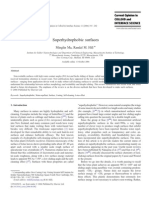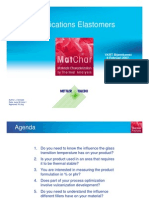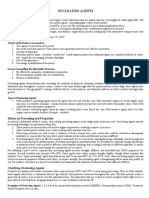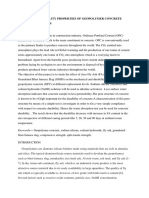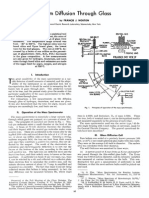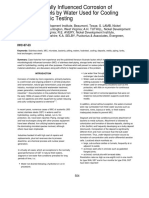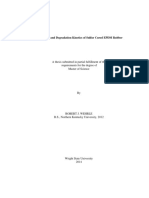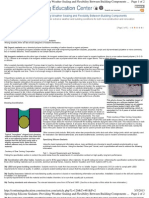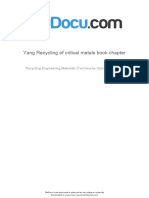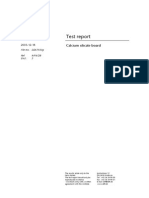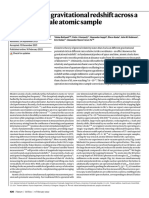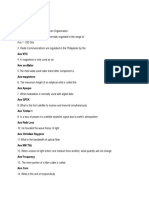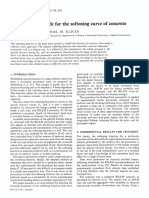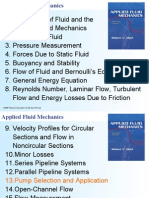Hydrophobic Glass Coated With Surface Modified Silica Film Prepared From Sodium Silicate PDF
Hydrophobic Glass Coated With Surface Modified Silica Film Prepared From Sodium Silicate PDF
Uploaded by
Irna I. SyafitriCopyright:
Available Formats
Hydrophobic Glass Coated With Surface Modified Silica Film Prepared From Sodium Silicate PDF
Hydrophobic Glass Coated With Surface Modified Silica Film Prepared From Sodium Silicate PDF
Uploaded by
Irna I. SyafitriOriginal Title
Copyright
Available Formats
Share this document
Did you find this document useful?
Is this content inappropriate?
Copyright:
Available Formats
Hydrophobic Glass Coated With Surface Modified Silica Film Prepared From Sodium Silicate PDF
Hydrophobic Glass Coated With Surface Modified Silica Film Prepared From Sodium Silicate PDF
Uploaded by
Irna I. SyafitriCopyright:
Available Formats
The 1st International Seminar on Fundamental and Application
of Chemical Engineering
ISFAChE 2010
November 3-4, 2010, Bali-Indonesia
Hydrophobic Glass Coated with Surface Modified-Silica Film Prepared
From Sodium Silicate
Heru Setyawan*, Vicky Samsiadi, and Ambarwati
Department of Chemical Engineering
Sepuluh Nopember Institute of Technology, Surabaya 60111 Indonesia
*
Corresponding Authors E-mail: sheru@chem-eng.its.ac.id
Keywords: Sodium silicate; sol-gel; hydrophobic silica film; surface modification.
Abstract
In this paper, we report on the hydrophobic coating of glass substrate with silica gel film based on
sodium silicate solution as the starting material. The silica gel film was formed by dip coating and
drying at room temperature. The silica gel film was made hydrophobic by surface modifying agent,
either using hexamethyldisiloxane (HMDS) or trimethylchlorosilane (TMCS), by solvent exchange
method. We found that the drawing speed during dip coating and the initial concentration of silica had
no significant effect on the hydrophobicity of the silica gel film. The hydrophobicity was measured by
measuring the contact angle of water on the film. However, the contact angle is greatly influenced by
the conditions during surface modification such as the concentration of surface modifying agent and
the contact time. A high contact angle of 142.5 can be obtained by modifying the silica gel film in
9.7 M TMCS solution at 50C for 7 hours. The transparency of the surface-modified silica gel film,
measured as the %transmittance using a spectrophotometer, slightly decreases compared to the glass
substrate. On average, they take the value of greater than 93.5% relative to that of the glass substrate.
1. Introduction
Hydrophobic surfaces have considerable technological potential for various applications due to
their excellent water-repellent properties. One of them is the self-cleaning application including selfcleaning windows, windshields, exterior paints for building, roof tiles, textiles, and drag reduction in
fluid flow. Hidrophobic surface are those on which the water contact angle is between 90-150 degrees.
Lotus leaf is a classical example of natural super-hydrophobic surface on which the contact angle of
water is larger than 150 degree. The super-hydrophobic and self-cleaning surface effects of lotus leaf
and other plant leaves such as rice and Indian cress is caused by the rough structure [1].
The increasing interest in studying and manufacturing hydrophobic surface results from their
possible practical applications. They find their primary use in corrosion, erosion or general
degradation protection applications on metallic, polymer and inorganic oxide (stone, glass, ceramic,
etc.) solid surfaces. In recent years, this field has evolved into a major industry trade which covers
modern applications from anti-fogging as well as water and snow repellent surfaces for construction
materials, glass, automotive and aerospace technology, all the way to reducing frictional drag on
airplane wings and ship hulls [2]. Glass coated with silica using tetraethylorthosilicate (TEOS) as the
silica source can make the glass surface hydrophobic and has a self-cleaning effect [3,4]. Self cleaning
is the key advantage which keeps the surface clean while rain water beads up and rolls over these
surface entrapping dirt and particulates. The use of an expensive material such as TEOS hinders their
practical applications.
In this work we report on a sol-gel derived method for coating glass substrate with a thin film of
silica by dip coating. The coating materials use sodium silicate as a silica precursor and
trimethylchlorosilane (TMCS) or hexamethyldisilazane (HMDS) as the surface modifying agent. The
use of cheap and non-toxic silicate precursor must be preferable than its counterpart alkoxide
compounds in the frame of environmentally friendly processes.
E003-1
The 1st International Seminar on Fundamental and Application
of Chemical Engineering
ISFAChE 2010
November 3-4, 2010, Bali-Indonesia
2. Experimental
Materials
The materials used for the preparation of hydrophobic glass coating were commercial microscope
glass slides of 25.4 76.2 1 mm as the substrate, sodium silicate solution (water glass, 28% SiO2,
SiO2:Na2O = 3.3) provided by PT. Ineos Silica Indonesia the silica as the precursor,
hexamethyldisilazane (Merck, p.a.) and trimethylchlorosilane (Merck, p.a.) as the surface modifying
agent, and methanol (Merck, p.a.) as the solvent exchange. All were used as supplied with no further
treatment except for the glass slides.
Method
The synthesis of silica films involves the following four key steps: (i) substrate pre-treatment for
good quality of films, (ii) preparation of silica sol from sodium silicate, (iii) dipping and drawing the
substrates in the silica sol, and (iv) surface modification of the silica film. Each step is described in
more detail below.
The pre-treatment of substrate was carried out by washing the glass slides with acetone for 15
min. The substrate was then dried in an oven at 105 oC. Silica sol was prepared from diluted sodium
silicate solution. The concentration of the dilute sodium silicate solution was ranging from 4.2 to 7.0
wt.%. The solution was then mixed with cation resin H+ with the volume ratio of 1:1 and stirred by
magnetic stirrer for 30 minutes to exchange Na+ ions in the sodium silicate solution with H+ ions. This
results silicic acid solution with a pH of about 2. This silicic acid solution was used as the precursor to
make silica film on the glass substrate.
Then, the pretreated substrate was coated with silica by dip coating method. In this case, the glass
substrate was dipped and then drawn at a speed of 7.5 cm/min unless otherwise stated. It was then
aged for 10 hours at room temperature in order to strengthen adhesion force between glass and silica
film. The modification of the silica surface was carried out by the solvent exchange method. This is
done by dipping the silica coated glass substrate into methanol for 1 h to exchange pore water with
methanol. This step is required because the surface modifying agents, i.e., TMCS and HMDS, are
immiscible with water. Then, the substrate was dipped in the TMCS or HMDS solution using
methanol solvent. The concentration of modifying agent was varied from 0.43 to 9.7 M, the dipping
time was from 1 to 9 hours and the temperature was at ambient temperature and 50 C. Finally, the
substrate was dried in an oven at 100 C for 2 hours.
Characterization
The hydrophobicity of the film was measured by measuring the contact angle of water dropped on
the film surface by a syringe. The contact angle measurement was done by photographing the water
drop using a camera (Sanyo, VPC-x1200) and measured the angle from the picture obtained. The
surface morphology of the films was observed by an optical USB Microscope (M-1 Scalar, ColePalmer) at 200x magnification. The transparency of the films was measured by measuring the
transmittance using UV-vis spectrophotometer (Genesys 10, Thermo Scientific).
3. Results and Discussion
Figure 1 shows the photographs of the water drop on the film prepared at various conditions and
an illustration on how to measure the contact angle from the images. The three photographs show the
films having contact angle greater than 90. It seems that a key factor to produce a hydrophobic film
is the successfulness to exchange silanol groups on the silica surface with alkyl groups. When we used
a lower concentration of HMDS or TMCS (< 1 M) to modify the silica surface, the contact angle is in
the range of about 80 to 87 degrees which indicates that the films are still hydrophilic. The low
concentration of the modifying agent makes the reaction to be in the regime of diffusion-limited. It
also happens for the case when the reaction time is too short to allow surface modification to occur.
With a reaction time of less than 3 hours, a contact angle greater than 90 could not be obtained.
Hence, in order to completely modify the silica surface, the concentration of modifying agent should
be high enough to overcome the diffusion limitation. In addition, the reaction time should be
sufficiently long to allow the reaction to be completed.
E003-2
The 1st International Seminar on Fundamental and Application
of Chemical Engineering
ISFAChE 2010
November 3-4, 2010, Bali-Indonesia
(d)
Figure 1. (a, b, c) Photographs of water drop on the surface of films at various preparation
conditions showing the films are hydrophobic; (d) Illustration of the contact angle
measurement using the photograph obtained.
Figure 2 shows the effect of silica precursor concentration on the contact angle for the films
prepared using TMCS as the surface modifying agent with a concentration of 9.5 M and a reaction
time of 7 h. We can see that the contact angle is greater than 90 which indicate that the film is
hydrophobic. It seems that the precursor concentration does not have significant effect on the contact
angle as it can be seen that by changing the silica precursor concentration, the contact angle remains
constant and it takes the value of about 110.
As explained before, in order to obtain hydrophobic coating, the silanol groups should be
exchanged completely with alkyl groups. It can be carried out by increasing the concentration of
modifying agent and/or lengthening the reaction time. Figure 3 shows the effect of reaction time on
the contact angle using TMCS as the surface modifying agent with a concentration of 9.7 M. It can be
seen that the contact angle increases significantly by the increase of reaction time. At a reaction time
of 3 h, the contact angle is still below 90 degree. It increases significantly to be 118 degree when the
reaction time is increased to 7 h and reaches 128 degree when the time is increased to 9 h. It confirms
that the completeness of groups exchange between silanol and alkyl is the key factor for the
successfulness to produce the hydrophobic coating.
150
140
Contact angle, degree
130
120
110
100
90
80
70
60
Silica concentration (wt.%)
Figure 2. Effect of silica concentration on the contact angle for the films prepared using
TMCS with a concentration of 9.7 M and reaction time of 7 h.
It was supposed that the reaction may be speed up by increasing the temperature as it is typically
the case for most reaction system. Hence, we tried to modify the silica film at a temperature of 50 C.
E003-3
The 1st International Seminar on Fundamental and Application
of Chemical Engineering
ISFAChE 2010
November 3-4, 2010, Bali-Indonesia
The contact angle of silica film prepared at silica concentration of 5.6 wt.% and TMCS concentration
of 9.7 M is 118 degree with reaction time 7 h. It increases significantly to be 142 degree when the
temperature is increased to 50 C while other conditions are kept the same.
150
140
Contact angle, degree
130
120
110
100
90
80
70
60
10
Reaction time, h
Figure 3. Effect of TMCS concentration on the contact angle for the films prepared
with a TMCS concentration of 9.7 M and a silica concentration of 5.6 wt.%.
It is sometimes desirable for some applications that the glass remains transparent after being
coated with hydrophobic silica. Figure 4 shows the effect of silica coating on the transmittance of
glass after being coated with hydrophobic silica in the visible range. The transmittance of the
uncoated glass substrate is also presented as comparison. It can be seen that comparing with the
uncoated glass, the transmittance of the coated glass only decreases slightly, i.e., the coating does not
influence the transparency significantly.
Figure 4. Effect of silica coating on the transpaency of the glass.
It has been demonstrated that the hydrophobicity of silica film is greatly dependent on the
amount of alkyl groups grafted on the silica surface. Comparing the two modifying agents, using the
E003-4
The 1st International Seminar on Fundamental and Application
of Chemical Engineering
ISFAChE 2010
November 3-4, 2010, Bali-Indonesia
same molar ratio of modifying agent and silicic acid, the contact angle of silica film modified with
HMDS is larger than that of TMCS. For example, the contact angle of silica film prepared using
silicic concentration of 5.6 wt.% modified with TMCS at a concentration of 0.43 M is only 39 degrees.
It increases significantly to be 80 degrees using HMDS. The reaction taking place for the two cases
can be written as
For HMDS:
For TMCS:
It clearly shows that if it requires one mole HMDS to modify one mole silicic acid. On the other hand,
it needs two moles TMCS for one mole silicic acid.
4. Conclusion
It has been demonstrated that hydrophobic glass can be produced by coating the glass with
alkyl-modified silica film. The hydrophobicity of the glass is greatly dependent on the successfulness
to exchange the silanol groups on the silica surface with alkyl groups. In order to enhance the
exchange reaction, a high concentration of modifying and/or a longer reaction time is required. The
transparency of the coated glass is not significantly influenced. The contact angle of the glass coating
with alkyl-modified silica is in the range of 118 to 142 degrees which indicate that the film is
hydrophobic.
Acknowledgements
This work has been partly supported by DGHE, The Ministry of National Education of Indonesia
through Research Grant of Strategis Nasional.
References
1. Cannavale, A., Fiorito, F., Manca, M., Tortorici, G., Cingolani, R., and Gigli, G. (2010)
Multifunctional bioinspired sol-gel coatings for architectural glasses. Building and Environment,
45:1233-1243.
2. Nadargia, D.Y., Guravb, J.L., El Hawia, N., Raoc, A.V., and Koebela, M. (2010) Synthesis and
characterization of transparent hydrophobic silica thin films by single step solgel process and dip
coating. Journal of Alloys and Compounds, 496:436441.
3. Yoneda, T., and Morimoto, T. (1999) Mechanical durability of water repellent Glass, Thin Solid
Films, 351: 279-283.
4. Radonjic, L., and Nikolic, L. (1998) Effect of The silica sol-gel coatings on the properties of glass
substrate, Ceramics International, 24:547-552.
E003-5
You might also like
- Silicon Nitride - Synthesis, Properties and Application (2012)Document176 pagesSilicon Nitride - Synthesis, Properties and Application (2012)Daud BabaNo ratings yet
- CuO Nanostructures Synthesis, Characterization, Growth Mechanisms, Fundamental Properties, and ApplicationsDocument130 pagesCuO Nanostructures Synthesis, Characterization, Growth Mechanisms, Fundamental Properties, and ApplicationsFerdousAnikNo ratings yet
- Martensite FormationDocument13 pagesMartensite FormationMatteo1980No ratings yet
- FSBGD MCQ Study Questions 2000Document119 pagesFSBGD MCQ Study Questions 2000api-2629165189% (19)
- Super Hydrophobic SurfacesDocument10 pagesSuper Hydrophobic SurfacesnanateNo ratings yet
- Carbon Nanotubes ApplicationsDocument7 pagesCarbon Nanotubes Applicationsvaisakh777No ratings yet
- 2016-01-26 - Nuplex - Enhancing The Performance of Waterborne Coatings Through The Polymerization of Super Hydrophobic MonomersDocument26 pages2016-01-26 - Nuplex - Enhancing The Performance of Waterborne Coatings Through The Polymerization of Super Hydrophobic MonomerselgendawyNo ratings yet
- Processes For Upgrading Metallurgical Grade Silicon To Solar Drade Silicon PDFDocument10 pagesProcesses For Upgrading Metallurgical Grade Silicon To Solar Drade Silicon PDFWillian Boneli de AlmeidaNo ratings yet
- Impact - Modified - Epoxymontmorillonite - NanocompositeDocument8 pagesImpact - Modified - Epoxymontmorillonite - NanocompositeVansala GanesanNo ratings yet
- Medical Applications of Diamond Particles and SurfacesDocument10 pagesMedical Applications of Diamond Particles and SurfacesJenner FeijoóNo ratings yet
- Nabaltec Broschure Alumina Based RefractoriesDocument40 pagesNabaltec Broschure Alumina Based Refractoriesanandi2621998No ratings yet
- New Raw Materials For Cationic UvebDocument8 pagesNew Raw Materials For Cationic UvebArturo RamirezNo ratings yet
- Best TGA Example of Applications ElastomersDocument37 pagesBest TGA Example of Applications Elastomers28192175No ratings yet
- Hingley - PHD ThesisDocument233 pagesHingley - PHD ThesisCicero Gomes de SouzaNo ratings yet
- Geopolymer Chemistry and ApplicationsDocument37 pagesGeopolymer Chemistry and ApplicationsLarissa GuimarãesNo ratings yet
- Novus Dentire LinerDocument2 pagesNovus Dentire LinerLang Dental Manufacturing Co., Inc.No ratings yet
- A Review of Mathematical ModellingDocument15 pagesA Review of Mathematical ModellingParamita HaldarNo ratings yet
- Accepted Manuscript: 10.1016/j.surfcoat.2017.01.025Document47 pagesAccepted Manuscript: 10.1016/j.surfcoat.2017.01.025Rosa VasquezNo ratings yet
- Synthesis of Copper Oxide Nanoparticles Using Simple Chemical Route PDFDocument3 pagesSynthesis of Copper Oxide Nanoparticles Using Simple Chemical Route PDFRobinsonNo ratings yet
- Active Metal BrazingDocument14 pagesActive Metal BrazingAngel Leon GeronimoNo ratings yet
- Silicates: John Kevin D. Villar Bs emDocument4 pagesSilicates: John Kevin D. Villar Bs emJohnKevinVillarNo ratings yet
- Nucleating Agents: Effects On Processing and PropertiesDocument1 pageNucleating Agents: Effects On Processing and PropertiesSdkmega HhNo ratings yet
- TiO2 Impact On Paint Weather ResistanceDocument8 pagesTiO2 Impact On Paint Weather Resistanceuocmogiandi_aNo ratings yet
- A Review - Weight Loss Studies On The Corrosion Behavior of Some Metals in Various MediaDocument8 pagesA Review - Weight Loss Studies On The Corrosion Behavior of Some Metals in Various MediaRonald GarciaNo ratings yet
- A Study On Durability Properties of Geopolymer Concrete Using Flyash and GgbsDocument13 pagesA Study On Durability Properties of Geopolymer Concrete Using Flyash and Ggbsbala rajuNo ratings yet
- DSMTS 0005 3 AlODocument4 pagesDSMTS 0005 3 AlOSimanchal KarNo ratings yet
- Standard AbrasivesDocument64 pagesStandard AbrasivesjupmozNo ratings yet
- Alpha Phase AluminaDocument266 pagesAlpha Phase AluminaböhmitNo ratings yet
- Helium Diffusion Through GlassDocument7 pagesHelium Diffusion Through GlassElenaNo ratings yet
- Microbiologically Influenced CorrosionDocument13 pagesMicrobiologically Influenced Corrosionalphading100% (1)
- Effect of Chemical Composition of Zinc Phosphating Solution On Phosphate Coating PropertiesDocument12 pagesEffect of Chemical Composition of Zinc Phosphating Solution On Phosphate Coating PropertiesJhon QsacNo ratings yet
- Calcination of Nickel-Alumina CatalystsDocument4 pagesCalcination of Nickel-Alumina CatalystsAnonymous 4PuFzAR100% (1)
- Measuring Water PenetrationDocument5 pagesMeasuring Water PenetrationMartin CharvezNo ratings yet
- A Perspective Approach To Sustainable Routes For Non-IsocyanateDocument30 pagesA Perspective Approach To Sustainable Routes For Non-IsocyanateThaís FernandaNo ratings yet
- SMS MV UK - Twinjection Hot Metal DesulphurisationDocument7 pagesSMS MV UK - Twinjection Hot Metal DesulphurisationChandra Bhushan SinghNo ratings yet
- Titanium-A New Metal For The Aerospace AgeDocument26 pagesTitanium-A New Metal For The Aerospace AgedouslasNo ratings yet
- Kanbara Reactor - Magnesium Mono-Injection and Lime-Vs-magnesium Co-InjectionDocument6 pagesKanbara Reactor - Magnesium Mono-Injection and Lime-Vs-magnesium Co-InjectionErnstLindemannNo ratings yet
- Grit Comparison ChartDocument3 pagesGrit Comparison ChartAlex LomakovNo ratings yet
- AER507 Lab ManualDocument39 pagesAER507 Lab Manualarmon_domingoNo ratings yet
- The Curing and Degradation Kinetics of Sulfur Cured EPDM RubberDocument61 pagesThe Curing and Degradation Kinetics of Sulfur Cured EPDM RubberWilliamNo ratings yet
- Polyurethane PDFDocument2 pagesPolyurethane PDFvtbk0% (1)
- Titanium Corrosion PDFDocument3 pagesTitanium Corrosion PDFSellappan MuthusamyNo ratings yet
- Corrosion and Surface Chemistry of MetalsDocument615 pagesCorrosion and Surface Chemistry of MetalsJulio CastañedaNo ratings yet
- Seminar ReportDocument19 pagesSeminar Reportvivekr84100% (1)
- Solidification ShrinkageDocument4 pagesSolidification ShrinkagesubavlNo ratings yet
- Utilization of Plastic Waste in Geopolymer Concrete State of The Art Review-22190Document5 pagesUtilization of Plastic Waste in Geopolymer Concrete State of The Art Review-22190Editor IJAERDNo ratings yet
- Chrom I TingDocument11 pagesChrom I TingAshish RawatNo ratings yet
- Yang Recycling of Critical Metals Book ChapterDocument34 pagesYang Recycling of Critical Metals Book ChapterSaymore HobwanaNo ratings yet
- Graphite and Magnesia Carbon RefractoriesDocument79 pagesGraphite and Magnesia Carbon RefractoriesmomenNo ratings yet
- 90-10 Copper-Nickel vs. Aluminum BrassDocument7 pages90-10 Copper-Nickel vs. Aluminum BrassMohamed AshfaqNo ratings yet
- Reduction of The Sliding Friction of Metals by The Application of Longitudinal or Transverse Ultrasonic VibrationDocument8 pagesReduction of The Sliding Friction of Metals by The Application of Longitudinal or Transverse Ultrasonic VibrationmnasiroleslamiNo ratings yet
- Objectives of Materials HandlingDocument7 pagesObjectives of Materials HandlingFaizan AhmedNo ratings yet
- Solidification and CrystallizationFrom EverandSolidification and CrystallizationDieter M. HerlachNo ratings yet
- CVD Silicon Carbide PDFDocument7 pagesCVD Silicon Carbide PDFreaktorenergiNo ratings yet
- 2003 SBI Calcium SilicateDocument10 pages2003 SBI Calcium SilicatevytoNo ratings yet
- Modern Surface Engineerin PDFDocument237 pagesModern Surface Engineerin PDFĐức Tùng NgôNo ratings yet
- New Metallic Materials-Al-Li AlloysDocument23 pagesNew Metallic Materials-Al-Li AlloyszorazhrNo ratings yet
- Materials Selection: DeskbookDocument4 pagesMaterials Selection: DeskbooklotannaNo ratings yet
- First Page PDFDocument1 pageFirst Page PDFarif rahman hakimNo ratings yet
- Ee2302 Emii Nov 2010Document2 pagesEe2302 Emii Nov 2010Belayneh TadesseNo ratings yet
- Teacher Notes: Map ProjectionsDocument2 pagesTeacher Notes: Map ProjectionsMusa Abubakar SuleimanNo ratings yet
- Auxiliary Power ConsumptionDocument3 pagesAuxiliary Power ConsumptionNicko LastardaNo ratings yet
- EET304 - M3 Ktunotes - inDocument47 pagesEET304 - M3 Ktunotes - inAkhilaNo ratings yet
- 2022 - JunYe - Nature - Resolving The Gravitational Redshift Across A Millimetre - Scale Atomic SampleDocument9 pages2022 - JunYe - Nature - Resolving The Gravitational Redshift Across A Millimetre - Scale Atomic Sample曾许曌秋No ratings yet
- Yr6 - Math - MA1 - Revision-Term 1-Part 2Document7 pagesYr6 - Math - MA1 - Revision-Term 1-Part 2Ahmed AliNo ratings yet
- 3d STDocument78 pages3d STshamik1978No ratings yet
- Preview TDP 1Document9 pagesPreview TDP 1KishoreNo ratings yet
- QuizDocument14 pagesQuizSethbaldovinoNo ratings yet
- Electrical Properties of Human BloodDocument4 pagesElectrical Properties of Human BloodulgenyNo ratings yet
- PAM410 DS en V02Document2 pagesPAM410 DS en V02Irfan AshrafNo ratings yet
- 6 Optics PDFDocument29 pages6 Optics PDFthinkiitNo ratings yet
- Single Actuator Wave-Like Robot (SAW) : Design, Modeling, and ExperimentsDocument14 pagesSingle Actuator Wave-Like Robot (SAW) : Design, Modeling, and ExperimentsAnonymous EP15XmgNo ratings yet
- The Effect of Size Thickness and Type of The Bonding Interlayer On Bullet Proof Glass As Per EN 1063Document4 pagesThe Effect of Size Thickness and Type of The Bonding Interlayer On Bullet Proof Glass As Per EN 1063Anonymous hk1fhAkwyNo ratings yet
- ORF309 StochasticprocessesDocument15 pagesORF309 StochasticprocessesDarren AlexisNo ratings yet
- Show All The Necessary Steps To Solve The Following ProblemsDocument2 pagesShow All The Necessary Steps To Solve The Following ProblemsMistireselassieNo ratings yet
- Aspen Flare System AnalyzerDocument1 pageAspen Flare System AnalyzerMiftah MasrurNo ratings yet
- Presented To The Civil Engineering Department de La Salle University - Manila First Term, A.Y. 2020 - 2021Document8 pagesPresented To The Civil Engineering Department de La Salle University - Manila First Term, A.Y. 2020 - 2021Ritik NihalaniNo ratings yet
- Steel Castings, Surface Acceptance Standards, Visual ExaminationDocument3 pagesSteel Castings, Surface Acceptance Standards, Visual ExaminationArun JacobNo ratings yet
- Wa0015Document9 pagesWa0015anosh khanNo ratings yet
- Anchor Block SizingDocument2 pagesAnchor Block SizingSaqib LaeeqNo ratings yet
- Atmel 11219 SmartEnergy ATSENSE-101-301-301H Datasheet4Document55 pagesAtmel 11219 SmartEnergy ATSENSE-101-301-301H Datasheet4Ivan BabicNo ratings yet
- M.E. ThermalDocument47 pagesM.E. Thermalvelmurugan100% (1)
- Metamaterials and Negative Refractive IndexDocument6 pagesMetamaterials and Negative Refractive IndexRohan KulkarniNo ratings yet
- (Guinea 1994) A General Bilinear Fit For The Softening Curve of ConcreteDocument7 pages(Guinea 1994) A General Bilinear Fit For The Softening Curve of ConcreteShazwanShahNo ratings yet
- Partial Molar VolumeDocument5 pagesPartial Molar VolumeCaryl FrancheteNo ratings yet
- 2005 Pearson Education South Asia Pte LTDDocument137 pages2005 Pearson Education South Asia Pte LTDDickson LeongNo ratings yet
- Mechanism of Spark Plasma SinteringDocument13 pagesMechanism of Spark Plasma Sinteringlakshmikreddy33% (3)




